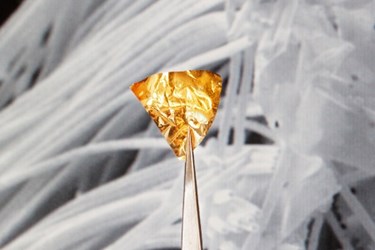Gold Nanotube Fabrication Goes Green Using Vitamin C
By Chuck Seegert, Ph.D.

To get away from the toxic chemicals used in traditional nanotube fabrication, scientists have developed a new, environmentally friendly method. Using vitamin C and other harmless chemicals, the new nanotubes are made from precipitated gold. The process is so effective that it may also be used to make nanotubes from platinum and palladium.
Creating nanotubes isn’t new and has traditionally been performed by using plastic as a mold. Tracks are generated in the plastic by bombarding the material with an ion beam, which leads to a precisely controlled tunnel that can have a metal precipitated within it. Historically, the chemicals used for this intricate nanotube fabrication process have included cyanide, formaldehyde, and heavy metal salts.
Inspired by another research team that used coffee to precipitate silver nanotubes, materials science doctoral candidate Eva-Maria Felix set out to do something similar, according to a recent press release from Technische Universität Darmstadt (TU).
"The chemicals that are usually used for this were just too toxic for me," said Felix in the press release.
Felix started with coffee, moved on to apple juice, and eventually settled on high-grade ascorbic acid (vitamin C), which is freely available from laboratory supply houses. In order to precipitate the gold, ions of the metal are suspended in solution containing vitamin C. Similar to the way vitamin C quenches free radicals in vivo, the molecule absorbs electrons from gold, thus enabling it to precipitate, or assume a solid form, one molecule at a time.
“I would drink the solution in the precipitation bath,” Wolfgang Ensinger, Felix’s thesis advisor, said in the press release. “This is truly green chemistry.”
The process is green by virtue of the safe chemicals it uses, according to the press release. Additionally, it can be performed at room temperature, so it uses very little energy.
Using the green method of electroless plating, Felix and her team were able to fabricate gold nanotubes with aspect ratios greater than 100, according to a recent paper published in RSC Advances. The key to this achievement was slowing the reaction down so that uniform metal deposition had time to take place on the deep inner surfaces of the plastic mold. Closed-wall nanotubes and porous nanotubes could be created by adjusting the timing of the deposition process. This process led to higher quality nanotubes than many other methods that have already been used.
The nanotubes may have application in the physiological testing of certain metabolites. One example is hydrogen peroxide, which has been implicated in neurodegenerative disorders, according to the press release. This would make the nanotubes useful for both medical research and diagnostics. The team is considering commercialization of the new method and has started looking for manufacturing partners that can create the plastic mold materials.
Nanotube technology is proliferating at a rapid rate due to the versatility of applications and the functions they can provide. Recently, in an article published on Med Device Online, a nanotube design was used that has the potential to bring handheld mass spectrometers closer to reality.
Image Credit: Sandra Junker
